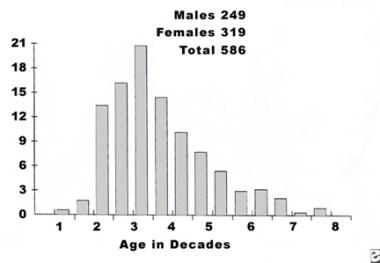

Cooper and Travers first described giant cell tumor (GCT) of bone in 1818.[1] GCTs of bone have been described as the most challenging benign bone tumors.[2] Although benign, GCTs show a tendency for significant bone destruction, local recurrence, and occasionally metastasis. The natural history of GCTs varies widely and can range from local bony destruction to local metastasis, metastasis to the lung, metastasis to lymph nodes (rare), or malignant transformation (rare).[3, 4, 5, 6, 7, 8, 9, 10, 11, 12, 13, 2, 14, 15, 16, 17, 18, 19]
Approximately 3% of GCTs metastasize to the lung. The metastases appear as clusters of GCTs located within the lung.[20, 5, 21, 22] GCT metastases generally appear an average of 3-5 years after the initial diagnosis of the primary lesion. In some cases, however, they may go undetected for 10 years or longer.[10, 21, 23, 22, 24] The natural history of these lung metastases is unpredictable. Pulmonary metastases that spontaneously regress, remain stable, continuously grow slowly, or rapidly progress have been reported.[20, 4, 10, 14, 25, 26]
NextIn the United States and Europe, GCTs represent approximately 5% of all primary bone tumors and 21% of all benign bone tumors.[19] In China, GCTs account for 20% of all primary bone tumors.[27] An epidemiologic comparison study between 9200 patients treated at Beijing Ji Shui Tan Hospital and 10,165 patients treated at the Mayo Clinic found that the incidence of GCT was significantly higher among the former.[28]
A female predominance exists, with a female-to-male ratio of 1.3-1.5:1 (see the image below).[29, 30, 19] GCTs occur most commonly in the third decade of life; less than 5% of GCTs occur in patients who are skeletally immature.[3, 19, 31, 32, 33] In the Mayo Clinic series, 84% of the GCTs occurred in patients older than 19 years.[19]
 Distribution of giant cell tumors according to age and sex of the patient. Six patients had multicentric disease.
Distribution of giant cell tumors according to age and sex of the patient. Six patients had multicentric disease. The overall prognosis generally is good. However, pulmonary metastases have been cited as the cause of death in 16-25% of reported cases.[10, 21, 23]
Clinical Presentation
Copyright © www.orthopaedics.win Bone Health All Rights Reserved